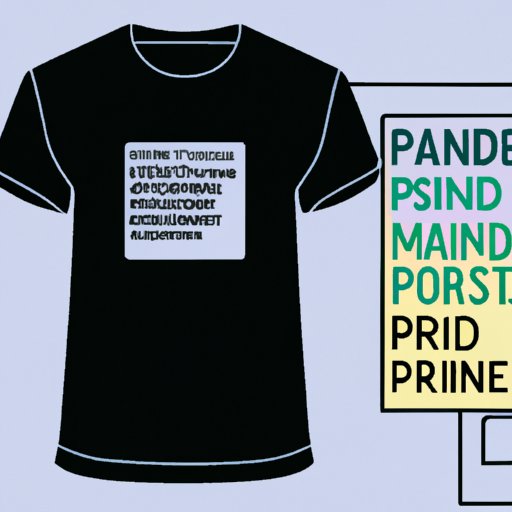Introduction
A print on demand t-shirt business is a good way to make money online. It is also relatively easy to get started in this type of business. With the right supplier and platform, you can create and sell your own custom t-shirts without having to buy or store any inventory. This article will provide an overview of what it takes to start a print on demand t-shirt business, including steps to getting started, different types of printing technologies, tips on choosing the right supplier and platform, and examples of successful businesses.
Overview of Print on Demand T-Shirt Business
Print on demand t-shirt businesses are becoming increasingly popular due to the ease of setup and low cost of entry. With a print on demand t-shirt business, you don’t have to purchase or store any inventory; instead, you simply design the t-shirts and upload them to the supplier’s platform. When customers order your shirts, the supplier prints and ships them directly to the customer.
Benefits of Starting a Print on Demand T-Shirt Business
There are many benefits to starting a print on demand t-shirt business. According to a survey conducted by Oberlo, a leading provider of dropshipping services, more than 50% of respondents said that one of the main reasons for starting a print on demand t-shirt business was to make money online. Other benefits include:
- Low startup costs – You don’t need to invest in inventory or expensive equipment.
- Flexibility – You can work from anywhere and set your own hours.
- Creative freedom – You can design and create your own unique t-shirts.
- Scalability – You can easily scale up or down depending on demand.
Steps to Getting Started in a Print on Demand T-Shirt Business
Getting started in a print on demand t-shirt business is relatively easy and straightforward. Here are the steps to setting up your business:
Choosing the Right Supplier and Platform
The first step to setting up a print on demand t-shirt business is to choose the right supplier and platform. There are many different suppliers and platforms available, so it is important to do your research and find the one that best meets your needs. Consider factors such as cost, quality, and turnaround time when making your decision.
Selecting the Printing Technology
Once you have chosen the supplier and platform, the next step is to select the printing technology. There are three main types of printing technologies used for t-shirt printing: screen printing, direct to garment (DTG) printing, and sublimation printing. Each type has its own advantages and disadvantages, so it is important to understand the differences before making your decision.
Designing the Shirts
The next step is to design the shirts. This is where your creativity comes into play. Think about the colors, images, and text that you want to use to create your t-shirts. Be sure to keep your designs simple and eye-catching, as this will help to attract customers.
Setting Up Your Storefront
Once you have designed the shirts, the next step is to set up your storefront. This is where you will showcase your t-shirts and promote your business. Consider factors such as website design, product descriptions, and pricing when setting up your storefront.
Promoting Your T-Shirts
The final step is to promote your t-shirts. There are many different ways to do this, including social media, email marketing, and paid advertising. It is important to experiment with different strategies to see which ones work best for your business.
Different Types of Printing Technologies
When it comes to printing t-shirts, there are three main types of printing technologies: screen printing, direct to garment (DTG) printing, and sublimation printing. Let’s take a look at each one in more detail.
Screen Printing
Screen printing is the most common type of printing used for t-shirt printing. It involves using a mesh screen to transfer ink onto the fabric. The advantage of screen printing is that it produces high-quality prints that are long-lasting and vibrant. However, it can be time-consuming and labor-intensive.
Direct to Garment (DTG) Printing
Direct to garment (DTG) printing is a newer type of printing technology that uses inkjet printers to print directly onto the fabric. The advantage of DTG printing is that it is fast and produces high-quality prints. However, it is more expensive than screen printing and may not be suitable for large orders.
Sublimation
Sublimation is a type of printing that uses heat to transfer dye onto the fabric. This type of printing produces vibrant and durable prints, but it is more expensive than other methods and requires specialized equipment.

Tips on Choosing the Right Supplier and Platform
When choosing a supplier and platform for your print on demand t-shirt business, it is important to consider several factors. Here are some tips to help you make the right decision:
Cost
The cost of the supplier and platform is an important factor to consider. Make sure to compare prices and look for any hidden fees or additional costs. It is also a good idea to look for discounts or promotions that may be available.
Quality
The quality of the prints is another important factor to consider. Make sure to read reviews and ask for samples to ensure that the prints are of high quality. It is also a good idea to test out the printing process yourself to make sure that everything works properly.
Turnaround Time
The turnaround time is also an important factor to consider. Look for suppliers and platforms that offer quick turnaround times so that your customers can receive their orders quickly.
Examples of Successful Print on Demand T-Shirt Businesses
There are many successful print on demand t-shirt businesses out there. Here are some examples of companies that have made it big in the industry:
Threadless
Threadless is a popular print on demand t-shirt company founded in 2000. The company allows users to submit their own designs and vote on others’ designs, and then prints and sells the winning designs. Threadless has become a leader in the industry, with over 10 million shirts sold.
Teespring
Teespring is an online marketplace for custom t-shirts. The company allows users to create and sell their own designs on the platform, and offers a variety of printing options. Teespring has seen tremendous success, with over $100 million in sales since 2012.
TeePublic
TeePublic is an online t-shirt store founded in 2013. The company offers a wide selection of designs from independent artists, and also allows users to upload and sell their own designs. TeePublic has become one of the leading players in the industry, with over 35 million products sold.
Conclusion
Starting a print on demand t-shirt business can be a great way to make money online. By following the steps outlined in this article, you can get started in this business quickly and easily. Consider factors such as cost, quality, and turnaround time when choosing a supplier and platform, and remember to select the right printing technology for your needs. Lastly, be inspired by the examples of successful print on demand t-shirt businesses to create your own successful business.
(Note: Is this article not meeting your expectations? Do you have knowledge or insights to share? Unlock new opportunities and expand your reach by joining our authors team. Click Registration to join us and share your expertise with our readers.)
